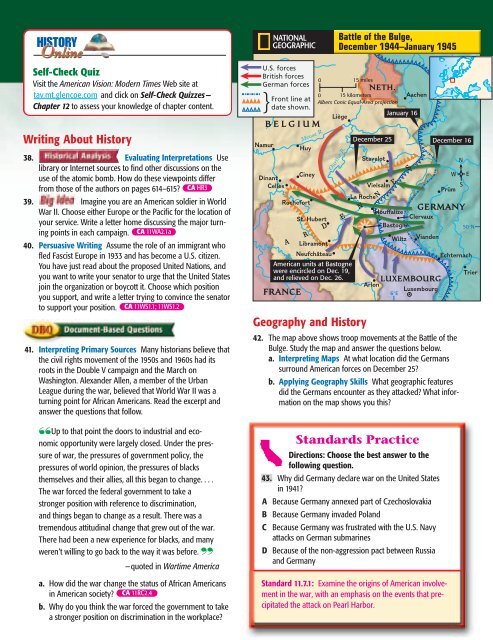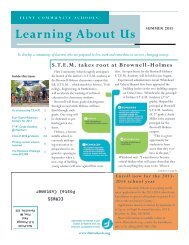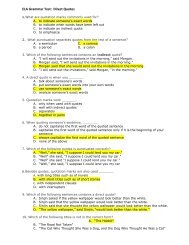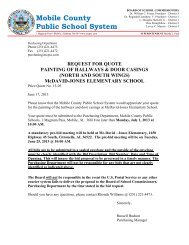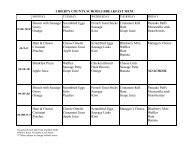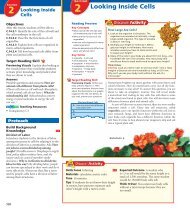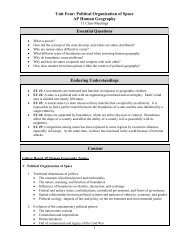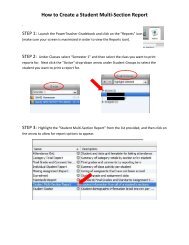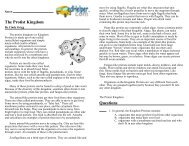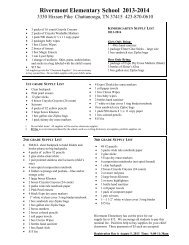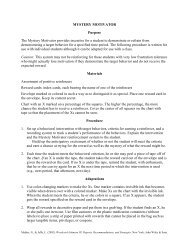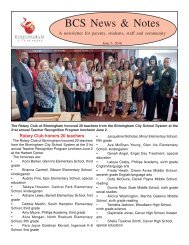Chapter 12: America and World War II, 1941-1945 - Georgia ...
Chapter 12: America and World War II, 1941-1945 - Georgia ...
Chapter 12: America and World War II, 1941-1945 - Georgia ...
You also want an ePaper? Increase the reach of your titles
YUMPU automatically turns print PDFs into web optimized ePapers that Google loves.
.<br />
HISTORY<br />
Self-Check Quiz<br />
Visit the <strong>America</strong>n Vision: Modern Times Web site at<br />
tav.mt.glencoe.com <strong>and</strong> click on Self-Check Quizzes—<br />
<strong>Chapter</strong> <strong>12</strong> to assess your knowledge of chapter content.<br />
Writing About History<br />
38. Evaluating Interpretations Use<br />
library or Internet sources to find other discussions on the<br />
use of the atomic bomb. How do these viewpoints differ<br />
from those of the authors on pages 614–615? CA HR3<br />
39. Imagine you are an <strong>America</strong>n soldier in <strong>World</strong><br />
<strong>War</strong> <strong>II</strong>. Choose either Europe or the Pacific for the location of<br />
your service. Write a letter home discussing the major turning<br />
points in each campaign. CA 11WA2.1a<br />
40. Persuasive Writing Assume the role of an immigrant who<br />
fled Fascist Europe in 1933 <strong>and</strong> has become a U.S. citizen.<br />
You have just read about the proposed United Nations, <strong>and</strong><br />
you want to write your senator to urge that the United States<br />
join the organization or boycott it. Choose which position<br />
you support, <strong>and</strong> write a letter trying to convince the senator<br />
to support your position. CA 11WS1.1; 11WS1.2<br />
41. Interpreting Primary Sources Many historians believe that<br />
the civil rights movement of the 1950s <strong>and</strong> 1960s had its<br />
roots in the Double V campaign <strong>and</strong> the March on<br />
Washington. Alex<strong>and</strong>er Allen, a member of the Urban<br />
League during the war, believed that <strong>World</strong> <strong>War</strong> <strong>II</strong> was a<br />
turning point for African <strong>America</strong>ns. Read the excerpt <strong>and</strong><br />
answer the questions that follow.<br />
Up to that point the doors to industrial <strong>and</strong> economic<br />
opportunity were largely closed. Under the pres-<br />
“<br />
sure of war, the pressures of government policy, the<br />
pressures of world opinion, the pressures of blacks<br />
themselves <strong>and</strong> their allies, all this began to change....<br />
The war forced the federal government to take a<br />
stronger position with reference to discrimination,<br />
<strong>and</strong> things began to change as a result. There was a<br />
tremendous attitudinal change that grew out of the war.<br />
There had been a new experience for blacks, <strong>and</strong> many<br />
weren’t willing to go back to the way it was before.<br />
”<br />
—quoted in <strong>War</strong>time <strong>America</strong><br />
a. How did the war change the status of African <strong>America</strong>ns<br />
in <strong>America</strong>n society? CA 11RC2.4<br />
b. Why do you think the war forced the government to take<br />
a stronger position on discrimination in the workplace?<br />
U.S. forces<br />
British forces<br />
German forces<br />
Namur<br />
Front line at<br />
date shown.<br />
5°E<br />
BELGIUM<br />
Dinant<br />
Celles<br />
A R<br />
<strong>America</strong>n units at Bastogne<br />
were encircled on Dec. 19,<br />
<strong>and</strong> relieved on Dec. 26.<br />
FRANCE<br />
15 miles<br />
Geography <strong>and</strong> History<br />
0<br />
Meuse R.<br />
Huy<br />
Ciney<br />
Rochefort<br />
St. Hubert<br />
Libramont<br />
Neufchˆateau<br />
0 15 kilometers<br />
Aachen<br />
Albers Conic Equal-Area projection<br />
January 16<br />
Li`ege<br />
Ourthe R.<br />
D E<br />
Battle of the Bulge,<br />
December 1944–January <strong>1945</strong><br />
NETH.<br />
December 25<br />
Stavelot<br />
N N<br />
42. The map above shows troop movements at the Battle of the<br />
Bulge. Study the map <strong>and</strong> answer the questions below.<br />
a. Interpreting Maps At what location did the Germans<br />
surround <strong>America</strong>n forces on December 25?<br />
b. Applying Geography Skills What geographic features<br />
did the Germans encounter as they attacked? What information<br />
on the map shows you this?<br />
St<strong>and</strong>ards Practice<br />
Our R.<br />
Directions: Choose the best answer to the<br />
following question.<br />
43. Why did Germany declare war on the United States<br />
in <strong>1941</strong>?<br />
A Because Germany annexed part of Czechoslovakia<br />
B Because Germany invaded Pol<strong>and</strong><br />
C Because Germany was frustrated with the U.S. Navy<br />
attacks on German submarines<br />
D Because of the non-aggression pact between Russia<br />
<strong>and</strong> Germany<br />
St<strong>and</strong>ard 11.7.1: Examine the origins of <strong>America</strong>n involvement<br />
in the war, with an emphasis on the events that precipitated<br />
the attack on Pearl Harbor.<br />
E<br />
Vielsalm<br />
La Roche<br />
6°E<br />
S<br />
Houffalize Clervaux<br />
Bastogne<br />
Wiltz<br />
LUXEMBOURG<br />
Arlon<br />
Luxembourg<br />
December 16<br />
Moselle<br />
W<br />
Pr¨um<br />
R<br />
N<br />
S<br />
GERMANY<br />
Vi<strong>and</strong>en<br />
E<br />
50°N<br />
Echternach<br />
Trier<br />
CHAPTER <strong>12</strong> <strong>America</strong> <strong>and</strong> <strong>World</strong> <strong>War</strong> <strong>II</strong> 621


